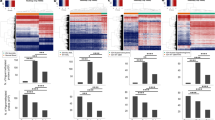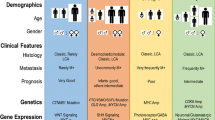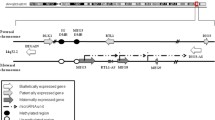Abstract
In Drosophila, the Slit gene product, a secreted glycoprotein, acts as a midline repellent to guide axonal development during embryogenesis. Three human Slit gene orthologues have been characterised and recently we reported frequent promoter region hypermethylation and transcriptional silencing of SLIT2 in lung, breast, colorectal and glioma cell lines and primary tumours. Furthermore, re-expression of SLIT2 inhibited the growth of cancer cell lines so that SLIT2 appears to function as a novel tumour suppressor gene (TSG). We analysed the expression of SLIT3 (5q35–34) and SLIT1 (1q23.3–q24) genes in 20 normal human tissues. Similar to SLIT2 expression profile, SLIT3 is expressed strongly in many tissues, while SLIT1 expression is neuronal specific. We analysed the 5′ CpG island of SLIT3 and SLIT1 genes in tumour cell lines and primary tumours for hypermethylation. SLIT3 was found to be methylated in 12 out of 29 (41%) of breast, one out of 15 (6.7%) lung, two out of six (33%) colorectal and in two out of (29%) glioma tumour cell lines. In tumour cell lines, silenced SLIT3 associated with hypermethylation and was re-expressed after treatment with 5-aza-2′-deoxycytidine. In primary tumours, SLIT3 was methylated in 16% of primary breast tumours, 35% of gliomas and 38% of colorectal tumours. Direct sequencing of bisulphite-modified DNA from methylated tumour cell lines and primary tumours demonstrated that majority of the CpG sites analysed were heavily methylated. Thus, both SLIT2 and SLIT3 are frequently methylated in gliomas and colorectal cancers, but the frequency of SLIT3 methylation in lung and breast cancer is significantly less than that for SLIT2. We also demonstrated SLIT1 promoter region hypermethylation in glioma tumour lines (five out of six; 83%), the methylation frequency in glioma tumours was much lower (two out of 20; 10%). Hence, evidence is accumulating for the involvement of members of the guidance cues molecules and their receptors in tumour development.
Similar content being viewed by others
Main
Epigenetic inactivation of tumour suppressor genes (TSGs) by promoter region CpG island hypermethylation is now well documented and several TSGs have been demonstrated to be inactivated by this mechanism (reviewed in Jones and Baylin, 2002; Herman and Baylin, 2003). In more recent years, a novel class of TSGs has been identified where epigenetic inactivation plays the predominant role, while somatic mutations are rare. This class of genes is exemplified by the 3p21.3 TSG, Ras association domain family 1A gene (RASSF1A) (Dammann et al, 2000; Lerman and Minna, 2000; Agathanggelou et al, 2001; Burbee et al, 2001). The CpG island in the promoter region of isoform A is frequently and heavily methylated in many types of cancers, including lung, breast, kidney, NPC, gastric, bladder, neuroblastoma, testicular, etc. (reviewed in Pfeifer et al, 2002; Dammann et al, 2003), while somatic inactivating mutations are absent or rare.
SLITs, ROBOs and Semaphorins belong to families of proteins that play important roles in axon guidance and cell migration in Drosophila and vertebrates (reviewed in Brose and Tessier-Lavigne, 2000; Wong et al, 2002). These proteins are widely expressed in mammalian tissues and the expression is not confined to neurons. Hence, they may have other yet unidentified roles. Slits are secreted proteins that are ligands for the Robo receptors (Brose et al, 1999; Kidd et al, 1999; Li et al, 1999). Recently, Slit was shown to inhibit leucocyte chemotaxis, this inhibition appears to be mediated by Robo (Wu et al, 2001). In mammals, four Robo genes have so far been identified, Robo1, Robo2, Rig-1 (Robo3) and magic Robo (Robo4) (Kidd et al, 1998; Girard et al, 2000; Goel et al, 2003). We have now demonstrated that SLIT3 5′ CpG island similar to SLIT2 is frequently hypermethylated in colorectal and glioma tumours and less so in breast tumours. And loss of SLIT3 expression can be reversed by treatment with a demethylating agent. While SLIT1 gene is frequently methylated in glioma tumour lines but at low frequencies in glioma tumours, hence SLIT1 may play a role in late gliomagenesis.
Slits, netrins, semaphorins and the ephrins constitute conserved families of axonal guidance cues that have prominent developmental effects. Recently, SEMA3B was also demonstrated to be inactivated in lung cancer by promoter region hypermethylation (Tomizawa et al, 2001; Kuroki et al, 2003). Re-expression of SEMA3B inhibited lung cancer cell growth and induced apoptosis.
The finding of epigenetic inactivation in various human cancers of ROBO1, SEMA3B, SLIT2 and now SLIT3 and to a lesser extent SLIT1, all of which are involved in axon and cell migration in Drosophila and vertebrates, suggests a novel, and common underlying theme for these molecules in tumour suppression.
Change history
16 November 2011
This paper was modified 12 months after initial publication to switch to Creative Commons licence terms, as noted at publication
References
Agathanggelou A, Honorio S, Macartney DP, Martinez A, Dallol A, Rader J, Fullwood P, Chauhan A, Walker R, Shaw JA, Hosoe S, Lerman MI, Minna JD, Maher ER, Latif F (2001) Methylation associated inactivation of RASSF1A from region 3p21.3 in lung, breast and ovarian tumours. Oncogene 20: 1509–1518
Astuti D, Da Silva NF, Dallol A, Gentle D, Martinsson T, Kogner P, Grundy R, Kishida T, Yao M, Latif F, Maher ER (2004) SLIT2 promoter methylation analysis in neuroblastoma, Wilms’ tumour and renal cell carcinoma. Br J Cancer 90: 515–521
Brose K, Bland KS, Wang KH, Arnott D, Henzel W, Goodman CS, Tessier-Lavigne M, Kidd T (1999) Slit proteins bind Robo receptors and have an evolutionarily conserved role in repulsive axon guidance. Cell 96: 795–806
Brose K, Tessier-Lavigne M (2000) Slit proteins: key regulators of axon guidance, axonal branching, and cell migration. Curr Opin Neurobiol 10: 95–102
Burbee DG, Forgacs E, Zöchbauer-Müller S, Shivakumar L, Gao B, Randle D, Virmani A, Bader S, Sekido Y, Latif F, Fong K, Gazdar AF, Lerman MI, White M, Minna JD (2001) Epigenetic inactivation of RASSF1A in lung and breast cancers and malignant phenotype suppression. J Natl Cancer Inst 93: 691–699
Dallol A, Da Silva NF, Viacava P, Minna JD, Maher ER, Latif F (2002a) SLIT2, a human homologue of the Drosophila Slit2 gene, has tumor suppressor activity and is frequently inactivated in lung and breast cancers. Cancer Res 62: 5874–5880
Dallol A, Forgacs E, Martinez A, Sekido Y, Walker R, Kishida T, Rabbitts P, Maher ER, Latif F (2002b) Tumour specific promoter region methylation of the human homologue of the Drosophila Roundabout gene DUTT1 (ROBO1) in human cancers. Oncogene 21: 3020–3028
Dallol A, Krex D, Hesson L, Eng C, Maher ER, Latif F (2003a) Frequent epigenetic inactivation of the SLIT2 gene in gliomas. Oncogene 22: 4611–4616
Dallol A, Morton D, Maher ER, Latif F (2003b) SLIT2 axon guidance molecule is frequently inactivated in colorectal cancer and suppresses growth of colorectal carcinoma cells. Cancer Res 63: 1054–1058
Dammann R, Li C, Yoon JH, Chin PL, Bates S, Pfeifer GP (2000) Epigenetic inactivation of a RAS association domain family protein from the lung tumour suppressor locus 3p21.3. Nat Genet 25: 315–319
Dammann R, Schagdarsurengin U, Strunnikova M, Rastetter M, Seidel C, Liu L, Tommasi S, Pfeifer GP (2003) Epigenetic inactivation of the Ras-association domain family 1 (RASSF1A) gene and its function in human carcinogenesis. Histol Histopathol 18: 665–677
Girard L, Zochbauer-Muller S, Virmani AK, Gazdar AF, Minna JD (2000) Genome-wide alleloty** of lung cancer identifies new regions of allelic loss, differences between small cell lung cancer and non-small cell lung cancer, and loci clustering. Cancer Res 60: 4894–4906
Goel A, Arnold CN, Niedzwiecki D, Chang DK, Ricciardiello L, Carethers JM, Dowell JM, Wasserman L, Compton C, Mayer RJ, Bertagnolli MM, Boland CR (2003) Characterization of sporadic colon cancer by patterns of genomic instability. Cancer Res 63: 1608–1614
Herman JG, Baylin SB (2003) Gene silencing in cancer in association with promoter hypermethylation. N Engl J Med 349: 2042–2054
Huminiecki L, Gorn M, Suchting S, Poulsom R, Bicknell R (2002) Magic roundabout is a new member of the roundabout receptor family that is endothelial specific and expressed at sites of active angiogenesis. Genomics 79: 547–552
Jones PA, Baylin SB (2002) The fundamental role of epigenetic events in cancer. Nat Rev Genet 3: 415–428
Kidd T, Bland KS, Goodman CS (1999) Slit is the midline repellent for the robo receptor in Drosophila. Cell 96: 785–794
Kidd T, Brose K, Mitchell KJ, Fetter RD, Tessier-Lavigne M, Goodman CS, Tear G (1998) Roundabout controls axon crossing of the CNS midline and defines a novel subfamily of evolutionarily conserved guidance receptors. Cell 92: 205–215
Kuroki T, Trapasso F, Yendamuri S, Matsuyama A, Alder H, Williams NN, Kaiser LR, Croce CM (2003) Allelic loss on chromosome 3p21.3 and promoter hypermethylation of Semaphorin 3B in non-small cell lung cancer. Cancer Res 63: 3352–3355
Lerman MI, Minna JD (2000) The 630-kb lung cancer homozygous deletion region on human chromosome 3p21.3: identification and evaluation of the resident candidate tumor suppressor genes. The International Lung Cancer Chromosome 3p21.3 Tumor Suppressor Gene Consortium. Cancer Res 60: 6116–6133
Li HS, Chen JH, Wu W, Fagaly T, Zhou L, Yuan W, Dupuis S, Jiang ZH, Nash W, Gick C, Ornitz DM, Wu JY, Rao Y (1999) Vertebrate slit, a secreted ligand for the transmembrane protein roundabout, is a repellent for olfactory bulb axons. Cell 96: 807–818
Pfeifer GP, Yoon JH, Liu L, Tommasi S, Wilczynski SP, Dammann R (2002) Methylation of the RASSF1A gene in human cancers. Biol Chem 383: 907–914
Plump AS, Erskine L, Sabatier C, Brose K, Epstein CJ, Goodman CS, Mason CA, Tessier-Lavigne M (2002) Slit1 and Slit2 cooperate to prevent premature midline crossing of retinal axons in the mouse visual system. Neuron 33: 219–232
Sundaresan V, Chung G, Heppell-Parton A, **ong J, Grundy C, Roberts I, James L, Cahn A, Bench A, Douglas J, Minna J, Sekido Y, Lerman M, Latif F, Bergh J, Li H, Lowe N, Ogilvie D, Rabbitts P (1998) Homozygous deletions at 3p12 in breast and lung cancer. Oncogene 17: 1723–1729
Tomizawa Y, Sekido Y, Kondo M, Gao B, Yokota J, Roche J, Drabkin H, Lerman MI, Gazdar AF, Minna JD (2001) Inhibition of lung cancer cell growth and induction of apoptosis after reexpression of 3p21.3 candidate tumor suppressor gene SEMA3B. Proc Natl Acad Sci USA 98: 13954–13959
Wong K, Park HT, Wu JY, Rao Y (2002) Slit proteins: molecular guidance cues for cells ranging from neurons to leukocytes. Curr Opin Genet Dev 12: 583–591
Wu JY, Feng L, Park HT, Havlioglu N, Wen L, Tang H, Bacon KB, Jiang Zh, Zhang Xc, Rao Y (2001) The neuronal repellent Slit inhibits leukocyte chemotaxis induced by chemotactic factors. Nature 410: 948–952
**an J, Clark KJ, Fordham R, Pannell R, Rabbitts TH, Rabbitts PH (2001) Inadequate lung development and bronchial hyperplasia in mice with a targeted deletion in the Dutt1/Robo1 gene. Proc Natl Acad Sci USA 98: 15062–15066
Yuan SS, Cox LA, Dasika GK, Lee EY (1999) Cloning and functional studies of a novel gene aberrantly expressed in RB-deficient embryos. Dev Biol 207: 62–75
Yuan W, Rao Y, Babiuk RP, Greer JJ, Wu JY, Ornitz DM (2003) A genetic model for a central (septum transversum) congenital diaphragmatic hernia in mice lacking Slit3. Proc Natl Acad Sci USA 100: 5217–5222
Acknowledgements
This work was in part supported by Breast Cancer Campaign and Cancer Research UK.
Author information
Authors and Affiliations
Corresponding author
Rights and permissions
From twelve months after its original publication, this work is licensed under the Creative Commons Attribution-NonCommercial-Share Alike 3.0 Unported License. To view a copy of this license, visit http://creativecommons.org/licenses/by-nc-sa/3.0/
About this article
Cite this article
Dickinson, R., Dallol, A., Bieche, I. et al. Epigenetic inactivation of SLIT3 and SLIT1 genes in human cancers. Br J Cancer 91, 2071–2078 (2004). https://doi.org/10.1038/sj.bjc.6602222
Received:
Revised:
Accepted:
Published:
Issue Date:
DOI: https://doi.org/10.1038/sj.bjc.6602222
- Springer Nature Limited
Keywords
This article is cited by
-
Perineural invasion in colorectal cancer: mechanisms of action and clinical relevance
Cellular Oncology (2024)
-
GREM1 signaling in cancer: tumor promotor and suppressor?
Journal of Cell Communication and Signaling (2023)
-
Molecular characterization of early breast cancer onset to understand disease phenotypes in African patients
Medical Oncology (2022)
-
Microarray data analysis on gene and miRNA expression to identify biomarkers in non-small cell lung cancer
BMC Cancer (2020)
-
Osteoclasts are not a source of SLIT3
Bone Research (2020)




